System Approach to Management Theory
Abstract
For any manager, irrespective of the function he heads, a comprehensive knowledge of the management principles and managerial skills are essential. This is very true in the case of the quality control managers. This chapter highlights the two aspects the manager has to deal with in his day-to-day affairs, viz. the systems approach and the decision theory.
Keywords
Management theory; Systems approach; Input-process-output; 5 Ms of input; System; Systemic; Systematic; Manufacturing system; Business organization system; Agricultural system; Automobile workshop system; Educational system; Elements of control; Environment; Open and closed systems; Subsystems; Generations of subsystems; Information flow; Operating data; Control data; Planning data; Series; Parallel and integrated combination of subsystems; Control systems with automatic and nonautomatic correction; Cube of management; Planning pyramid; Decision theory; Problem analysis versus decision-making; Decision tree; Logical fault location; Decision-making under certainty; Risk; Uncertainty and under conflicts; Systematic decision-making
6.1 Development of System Approach
In the past, the departmental mangers tried to solve their problems by considering them as isolated situations, independent of other activities of the organization. For example, if a certain product manufacturer noticed a sales decline and traced it to the lack of aggressive sales effort, it was treated purely as a sales management problem and action was taken against that particular salesman or the department. The contribution of other departments to this effect, such as the quality control, design, credit policy, or the advertising, were never given much thought. Life study of any object must rely on the method, of analysis involving the simultaneous variations of mutually dependent variables. As early as the 1950s, a new integrated approach which considers the management in its totality has been developed and this is called the system approach.
6.2 What is a System?
We are surrounded by and live in several systems. In fact, man is a system by himself. Some systems are natural like the planetary systems, animal systems, and environmental systems. Others are man-made, like the business systems, production systems, material handling systems, social systems, and total quality management systems. Whichever is the system, it is basically characterized by three components which form the input-process-output system (Fig. 6.1), with,
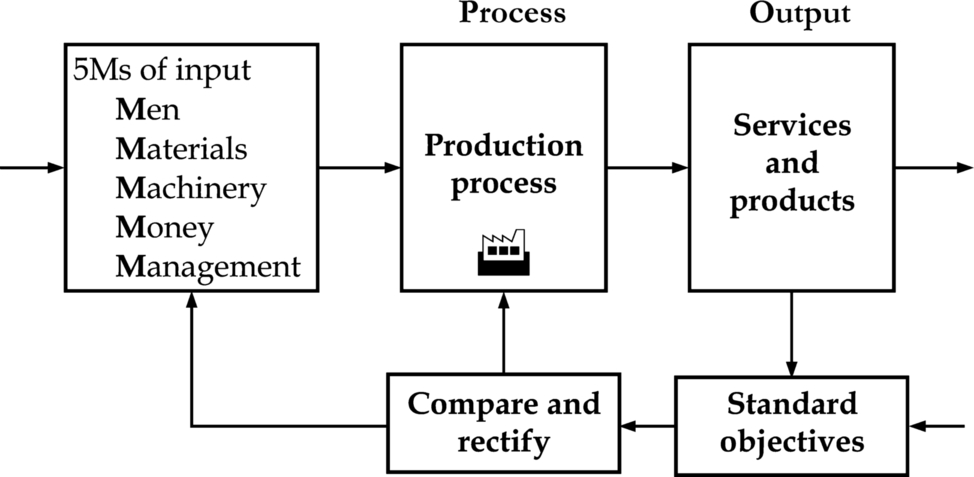
● a set of two more elements forming the input,
● seeking a common goal operating on certain data or matter or energy, forming the process, and
● yield matter or data in a time frame, forming the output.
6.3 Definition of a System
Originating from the Greek word sustema, the word system has three definitions in the Oxford dictionary as below,
1. Group of things or parts working together, like the digestive system, railway system, or the control system or in computer field, a group of related hardware units, or programs, or both. Its adjective is systemic, meaning related to a system as a whole.
2. A set of ideas, theories or principles, or the social order like a political system or a government system.
3. Orderliness or methodical or an organized manner of working. Its adjective is systematic and the word systematize means arranging things according to a system.
The American Management Association in its AMA Management Handbook explains these three groups of definitions as follows:
1. The first group related systems to living creatures, including human beings, emphasizing the impact of personality and behavioral sciences.
2. The second group emphasized the general meaning of the system as a set of two or more elements like people, things or concepts, which are related or joined together to achieve a common goal, operating on data, matter and energy, to yield a result with a time reference. For example, a system of government, a system of measurement, or a system of classification.
3. The third group of definitions connects systems with specific science techniques like philosophy, mathematics, or biography.
Whatever may be the definition, a system approach is a purposeful and powerful means for accomplishing an objective. It provides the management with analytical framework with which it can identify, describe, and interrelate the process and the components that make up a particular system, as explained and illustrated in the following paragraphs. The study of any object or process must rely on the methods of analysis involving the simultaneous variations of mutually dependent variables.
6.4 Types of Systems
This concept of system approach is universal and can be applied to any situation, whether manufacturing or service provision, or agriculture, or even education. As illustrated below by the following figures:
1. Manufacturing system: A group of men working on machinery and materials with the aid of money and a good management, (5 Ms of input), working per work-methods, schedules, and specifications (process) to yield the specified products and information by the date the customer wants them (output) (Fig. 6.1).
2. Management information system: A group of people with a set of manuals, data processing, and recording equipment (input), working on selecting, storing, processing, and retrieving data (process) to yield the information needed by the managers (output) (Fig. 6.2).

3. Business organization system: A group of people with a vision and mission (input), performing production, design, finance, marketing, etc. functions (process) towards achieving the goal of optimal profit for the business (output) (Fig. 6.3).

4. Agricultural system: A group of people with a set implements, fertilizers, and land (input), performing the farming activity (process) to yield the agricultural produce (output) (Fig. 6.4).

5. Automobile workshop system: A group of people with spares, materials, tools, equipment, and management (input), maintaining and repairing the automobiles (process) to provide the required services to the customer (output) (Fig. 6.5).

6. Educational system: Faculty aided by college infrastructure, textbooks, visual aids, etc. (input) teaching and training the students (process) to provide enlightenment (output) (Fig. 6.6).
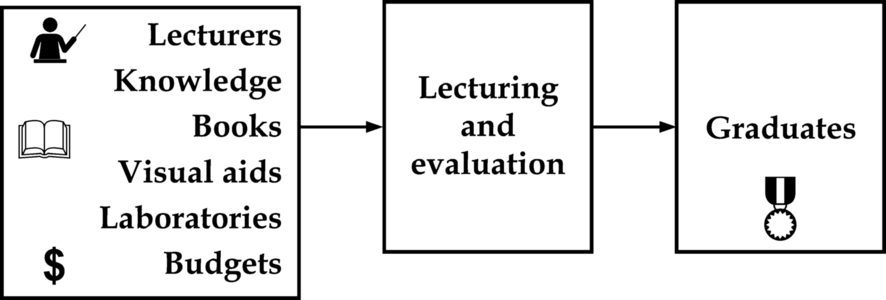
6.5 Components of a System
Systems are most often represented in flow charts and block diagrams. The major components of a system are input, process, and output. While Fig. 6.1 indicates the process in its simple form, Fig. 6.7 below illustrates all the other controlling factors.

6.5.1 Input
Input to a system can be classified basically in three categories. The first is comprised of the physical inputs, including the materials that flow through the conversion process where work is performed on them. The second is the nonphysical materials, but that are required for the performance of the process, like the management, money, capital, energy, labor, and land. They third category is the environment that effects the system’s operation. The design of the amount, placement, timing, and types of these inputs will have an impact on the conversion facility, whether it is a factory, a hospital, or an office.
6.5.2 Conversion Process
The second basic part if the system is the conversion process through which the inputs flow to produce the desired outputs. To be effective and efficient, systems must be designed so that the correct process acts on the inputs at the proper time.
6.5.3 Output
The third major component of the system after the conversion process is the output, which comprises the desired accomplishment of the system. In the automobile industry, the output is the number of completed cars of a desired quality produced within a specified time frame. This input—process—output elements would exist whatever the situation, whether agriculture or educational, etc., as explained in the following paragraphs.
6.6 Elements of Control in System Approach
Just as goals or objectives are needed in the design of a system, control is required in its operation. The purpose of the control is to maintain the quality and quantity of the output so that it meets the goals of the system. In the ideal case, the control would be self-regulating and hold the output at desired levels without outside intervention. The control has the following elements.
2. An output standard
3. A measuring device
4. A feedback signal
5. A corrective course of action
Unfortunately, in most management situations, not all of the elements of control are present, or are not precisely defined. For example, consider a production process in which the standard of the units of output per hour has been established for a product. However, when the output from the process is monitored, it is found that only 80% of the units are produced per hour. In this situation, there is an objective, an output standard, a measuring device, and a feedback signal, but no corrective action has been specified.
The control system can either be automatic or nonautomatic, as illustrated in the following figures.
6.7 Effect of Environment on the Systems
A system’s environment is composed of all activities outside the system which, if changed, will affect the system or which will be changed by any changes in the system itself. In this context, the general level of economic activity can be considered as environmental for most production activities, because any change in it will affect the production levels.
6.8 Open and Closed Systems
Every system has a boundary which functions to maintain proper relationships between the system and the environment. A closed system has no environment around the system. No outside systems have any effect on this system and the inputs and outputs have definite mathematical relationships like a chemical process inside a hermitically sealed container (Fig. 6.8A).

The open system has an environment with which it relates exchanges and communicatoin, such as human systems or a production system (Fig. 6.8B).
6.9 Systems and Subsystems
Because of the complexity of most real systems, it is extremely difficult to work with or to understand the entire system. In order to overcome this problem, systems are broken into smaller subsystems and still smaller sub-subsystems to comprehend them better. For example, the whole universe is a system, while the solar system is its subsystem. We may still break it down to the earth system, world system, a group of nations, a country system, a social system, man as a system, blood circulation system, etc., as illustrated in Fig. 6.9 shown alongside.
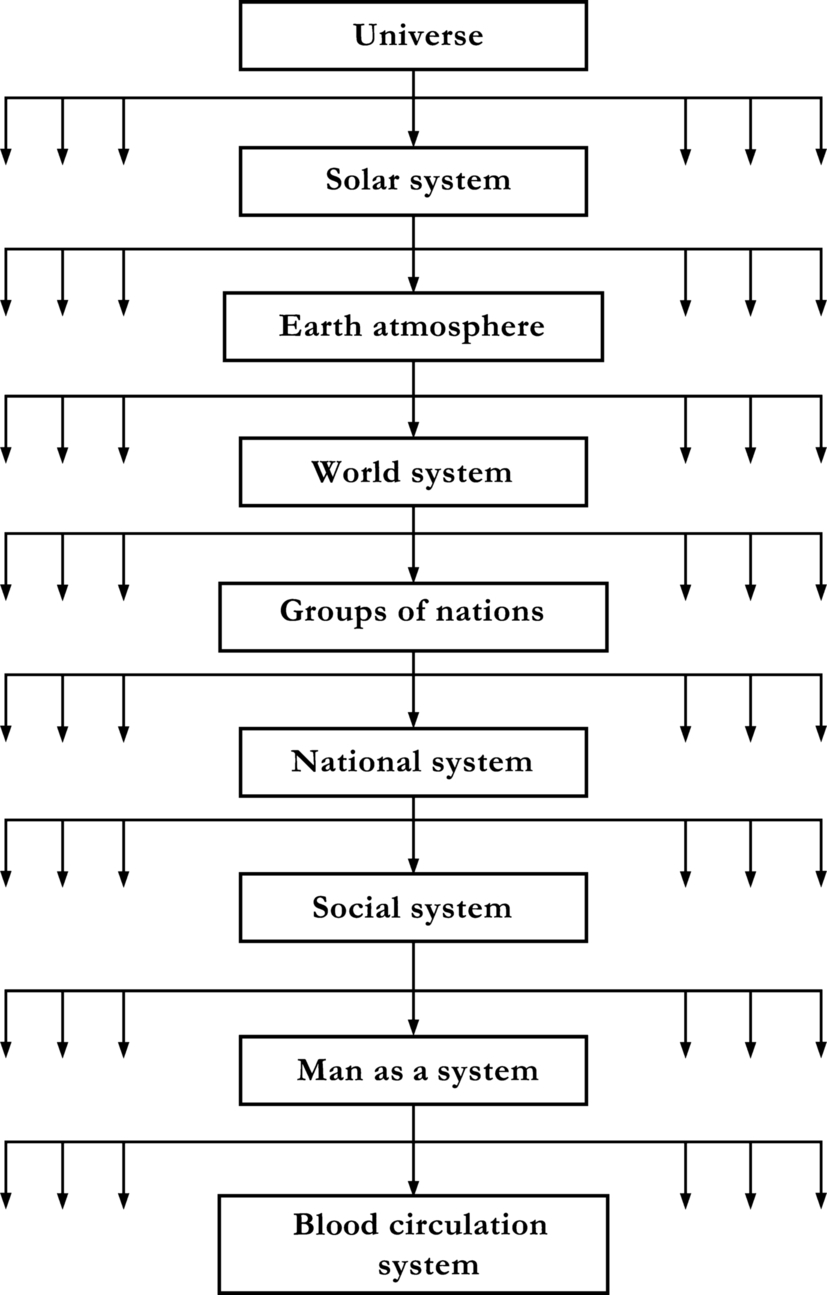
6.10 Relationship Between the Systems and Subsystems
Each system and its subsystems are mutually related, some more and some less, some directly and some indirectly. This relationship is in the context of the whole and is complex. Any change in one part would affect the other to a varying, but a predictable degree. Fig. 6.10 illustrates the relationship between the systems and Fig. 6.11, the different generations of subsystems.
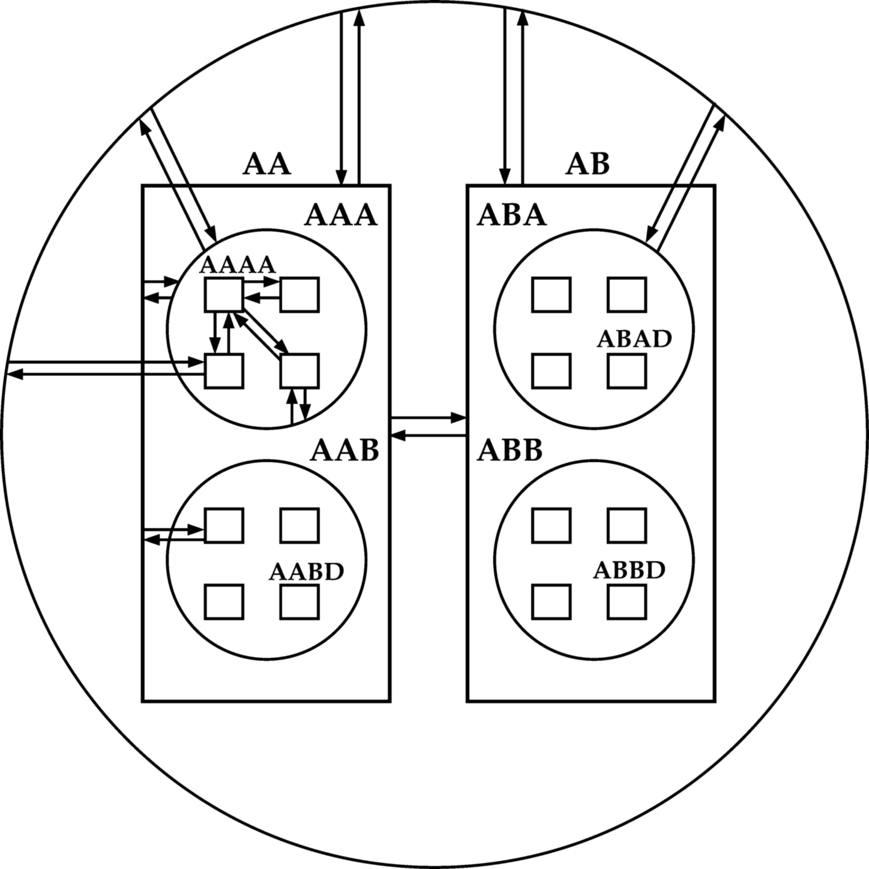

6.11 Combination of Subsystems
Two or more subsystems can be integrated in either series, or in parallel, or in combination, as illustrated in Fig. 6.12.



6.12 The Management Cube
The management activity is influenced by three aspects:
1. The management processes, including the planning, controlling, and execution.
2. The management functions such as design, planning, maintenance, marketing, purchasing, personnel, and finance.
3. The management level, such as operatives, supervisors, engineers, managers, directors, president, and Chairman.
These three activities can be illustrated by Fig. 6.13, which is called the management cube. It shows how the managers of different functions perform the processes at different levels.
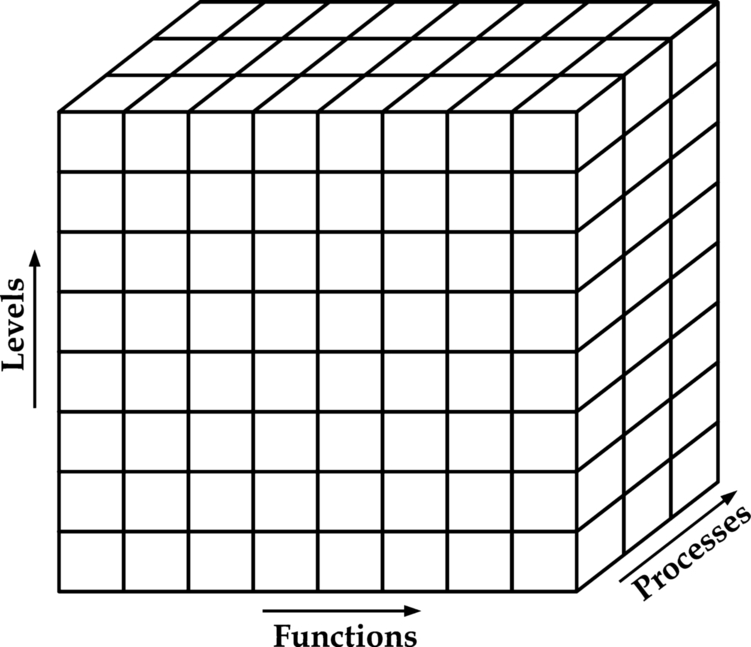
6.13 Planning Pyramid
The management cube considers the same number of managers at each level. But in fact, the number of persons in each level becomes less at a higher level because of the span of control. For example, the planning of the vision and mission, or the policy-making is done at the Chairman level, while the day-to-day operational planning is done at the manager level. As one ascends higher in the hierarchy, the level of planning is escalated and simultaneously, the number of individuals responsible narrows down.
Hence, these activities are better represented by a pyramid signifying this aspect and showing what type of planning is done at each level in the organization, as illustrated in Fig. 6.14.
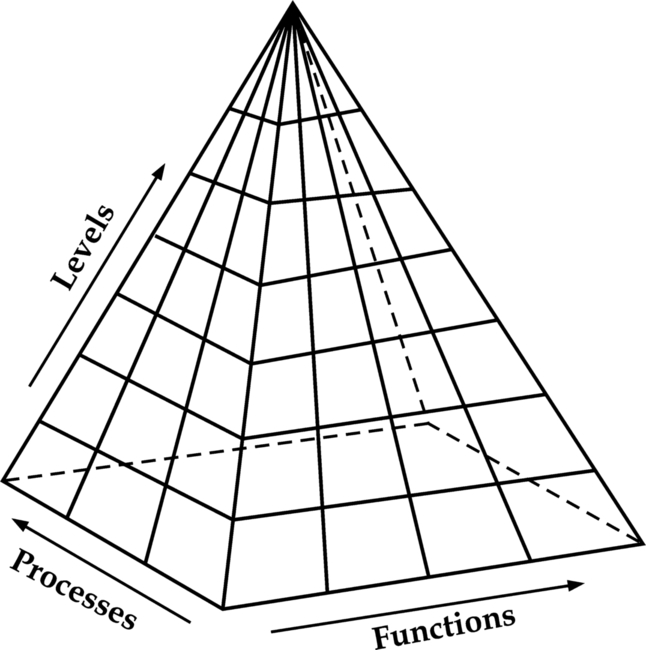
6.14 Summary of the Features of Management as a System
All the points described in the previous paragraphs can be summarized below:
1. Management is a system: Management can be defined as a system, and unlike the biological and mechanical systems, it has the characteristics of a social system. It has subsystems which are integrated as a whole.
2. Management is an open system: It has an environment and with interaction, management takes its resources or inputs, allocates, and combines the resources to produce the desired outputs to the environment.
3. Management is dynamic: The equilibrium of the organization is ever-changing, moving toward the growth and expansion by preserving some of its energy. Thus, the organizational effectiveness is determined by the ratio of energy exchanges.
4. Management is probabilistic: A deterministic model always specifies the use of a situation in a condition with predetermined results. Management being probabilistic, points out only the probability and never the certainty of performance and the consequent results. Nevertheless, for aiding decision-making, the management assumes a certain amount of deterministic models to arrive at some conclusions and then do the analysis in combination with the probabilistic approach.
5. Management is multidimensional: System approach points out complex multilevel and multidirectional characters. At the macro level, management can be applied to the business systems as a whole. At the micro level, it can be applied to an organized unit or any if its elements.
6. Management has multiple variables: There is no simple cause-effect phenomenon like in physics. An event may be a result of so many variables which themselves are interrelated and interdependent.
7. Management is adaptive: The survival and growth of an organization in a dynamic environment demands an adaptive system that continuously adjusts to a changing environment through a feedback mechanism. The feedback mechanism provides information to take corrective action for achieving the desired results.
8. Management is multidisciplinary: Management being a system draws integrated knowledge from several disciplines and schools of thought. In fact, integration of the relevant aspects of various disciplines is the real contribution to the management as a system.
6.15 Decision Theory
While the previous paragraphs illustrate the systems approach to decision-making, the following paragraphs illustrate the aspect of decision-making as relevant to the manager.
The day-to-day administration of the affairs of any business enterprise requires an endless sequence of decisions. Decision-making is an integral part of a team, given the responsibility of meeting and discussing among themselves toward the achievement of a goal. They may either be routine or unusual, demanding the manager’s closest attention and intelligence.
Actually the terms—to decide, to determine, to settle, and to conclude are generally used as synonyms, but we may distinguish between them as follows;
● To decide implies the bringing to an end any doubt, dispute, vacillation, or wavering between choices, by making up one’s mind on what to do, the course of action, etc.
● To determine, in addition to the above, suggests or fixes precisely the form, character, functions, scope, etc.
● To settle stresses finality in decision, often the one arrived at by an arbitrational process and implies the termination of all doubts and controversy.
● To conclude means to decide after careful investigation reasoning.
In the past, when it was mostly a sellers’ market, profit maximization was perhaps the sole motto of an enterprise, and accordingly, all decision-making was simple. But today, the manager is influenced by a hoard of factors.
1. Increased regulation of business activity by the local or national governments.
2. Growing separation of ownership and management in industry resulting in the management becoming more and more professional.
3. Steadily increasing importance given to high-level education for managers.
4. Development of new processes and equipment.
5. Expansion of market areas in view of improved communication and transport logistics.
6. Increased competition from other suppliers.
7. Growth of labor unions and more stringent labor laws.
8. Growing social pressure.
The following paragraphs detail the decision theory with regards to identifying its rationality, uncertainties, and other issues relevant in a given decision, as well as the resulting optimal decision.
6.16 Problem Analysis and Decision-Making
Traditionally, problem analysis must be done first, so that the information gathered in that process may be used towards decision-making. Wikipedia highlights the criteria for problem analysis and effective decision-making as follows.
6.16.1 Problem Analysis
● Analyze performance, what should the results be against what they actually are.
● Problems are merely deviations from performance standards.
● Problem must be precisely identified and described.
● Problems are caused by a change from a distinctive feature.
● Something can always be used to distinguish between what has and hasn’t been affected by a cause.
● Causes of problems can be deducted from relevant changes found in analyzing the problem.
● Most likely cause of a problem is the one that exactly explains all the facts.
6.16.2 Decision-Making
● Objectives must first be established.
● Objectives must be classified and placed in order of importance.
● Alternative actions must be developed.
● The alternative must be evaluated against all the objectives.
● The alternative that is able to achieve all the objectives is the tentative decision.
● The tentative decision is evaluated for more possible consequences.
● The decisive actions are taken, and additional actions are taken to prevent any adverse consequences from becoming problems and starting both systems (problem analysis and decision-making) all over again.
● There are steps that are generally followed that result in a decision model that can be used to determine an optimal production plan.
● In a situation featuring conflict, role-playing is helpful for predicting decisions to be made by involved parties.
6.17 Characteristics of Decision-Making
Decision-making involves the following characteristics
● Decision-making is a process of selection and the aim is to select the best alternative.
● A decision is aimed at achieving the objective of an organization if it is made in the organizational context.
● It involves evaluation of available alternatives, because only by this evaluating can one know the best alternative.
● Decision-making is a mental process and the final decision is made after thoughtful consideration.
● A decision involves rationality because by this, one can better one’s happiness.
● Decision-making involves certain commitment. This commitment may be for a short run or long run, depending upon the type of decision.
6.18 Situations Under Which Decisions are Taken
6.18.1 Decision-Making Under Certainty
Decision-making under certainty, when we know with confidence what will occur. In this case, we have to consider only one possibility of occurrence for every alternative and decision-making is very simple.
6.18.2 Decision-Making Under Uncertainty
Decision-making under uncertainty, when there are a number of alternatives and no past data is available to compute or estimate the probability of occurrence. The estimation of market demand for new and untested products is an illustration.
6.18.3 Decision-Making Under Risk
Decision-making under risk, when there are a number of possible alternatives and the probability of occurrence of each alternative, based on past data and past experience, is known. This is controlled by the theory of probability and the result may either turn out to be correct or wrong, depending upon the accuracy of the data or the evaluation procedure.
6.18.4 Decision-Making Under Conflicts
Decision-making under conflicts, when the different individuals involved directly or indirectly in decision-making have contradictory opinions or data. The discussion among the team members for arriving at a decision is an illustration.
Illustration on the lighter side for the Decision-making shown below:
A sea captain on a rough sea may make a decision depending upon his attitude. An optimist expects the weather to change and takes no action. A pessimist complains about the wind, prays for the heavenly abode (moksham) for all, and keeps the crew on tenter hooks. A realist adjusts the sails, takes control of navigational aids, and takes emergency precautions.
6.19 Classifications of Decisions
There are several ways of classifying decisions in an organization.
6.19.1 Organizational and Personal Decisions
In an organization when an individual makes decisions as an executive for the organization they are called organizational decisions. The authority for making such decisions can be delegated from a superior to a subordinate. Such decisions directly affect the functioning of the organization. On the other hand, an executive can also make personal decisions that affect his and his family’s personal life, though sometimes these decisions may affect the organization also. In this case, the decision-making power cannot be delegated.
6.19.2 Routine and Strategic Decisions
Routine decisions are made in the context of day-to-day operation of the organization. They are mostly repetitive in nature. They do not require much analysis and evaluation and can be made quickly. Authority of making these decisions is generally delegated to the lower level of workface. Strategic decisions are those primarily for the future. They affect the organizational structure, objectives, facilities, finances, etc. These decisions are mostly nonrepetitive in nature and are made after careful analysis and evaluation of various alternatives and are generally made at higher levels of management.
6.19.3 Policy and Operative Decisions
This classification is generally similar to the above, except that they refer more to the factory-level production planning decisions. Decisions like plant location, plant layout, volume of production, machinery selection, sale and purchase decisions can be called policy decisions. These are sometimes published as a policy manual to become the basis for other operative decisions. Operative decisions are production-line decisions, such as the scheduling, routing, etc. and can be called operative decisions.
6.19.4 Programmed and Nonprogrammed Decisions
Programmed decisions are generally repetitive in nature and are made within the broad policy structure. They have short-run impact and are made by lower level managers. Nonprogrammed decisions are those made whenever specific problems arise unexpectedly due to certain circumstances. They are generally nonrepetitive in nature.
6.19.5 Individual and Group Decisions
This classification is based on the persons involved in the decision-making process. Individual decisions are made by a single person, generally the head of the institution, with or without consulting others affected. These are taken in the context of routine programmed decisions, where the analysis of various alternatives is simple and for which broad policy manuals are provided. Sometimes important nonprogrammed decisions also are made by individuals. Group decisions are made by groups or teams constituted for this purpose. These decisions are, in general, very important to an organization. They have certain positive values, such as greater participation of individuals and quality of the decision, but at the same time have certain negative values like delay in decision-making and difficulty in fixing responsibility for the decision-making process and the follow-up action.
6.20 Different Approaches to Decision-Making
The different approaches adapted for managerial decision-making offer an insight into the theory of decision-making useful in teamwork.
6.20.1 Intuitive Decision-Making
In history there have been specialist decision-makers such as the tribal chiefs, medicine men, priests, and kings who depended mostly on their hunches or intuitions based on their training and experience. They actually involved unstructured gathering and classifying of historical data, followed by subjective evaluation.
6.20.2 Trial and Error Decision-Making
This is an adaptation of the intuitive decision-making, when the problem is subjectively isolated, defined, and a course of action is selected, and followed. If the results are favorable, the decision is allowed to stand. However, if the results tend to become failures, a second course of action is followed.
6.20.3 Follow-the-Leader Decision-Making
Here the decision is based on similar issues by other firms or an accepted trade practice, emphasizing that, “if it works fine with them, why not for us?” While this approach minimizes the risk, its main disadvantage lies in the fact that solutions depend very much upon the specific situations, which may vary from case to case and individual to individual. And besides, the variables in the same situation may change from time to time.
6.20.4 Scientific Decision-Making
Here each problem is analyzed considering each of the alternative solutions. This process of analysis has been adapted in the physical services for centuries. The main four steps are:
● develop a hypothesis,
● test the two hypotheses, and
● prove or disprove the hypotheses.
This is better understood by Fig. 6.15.
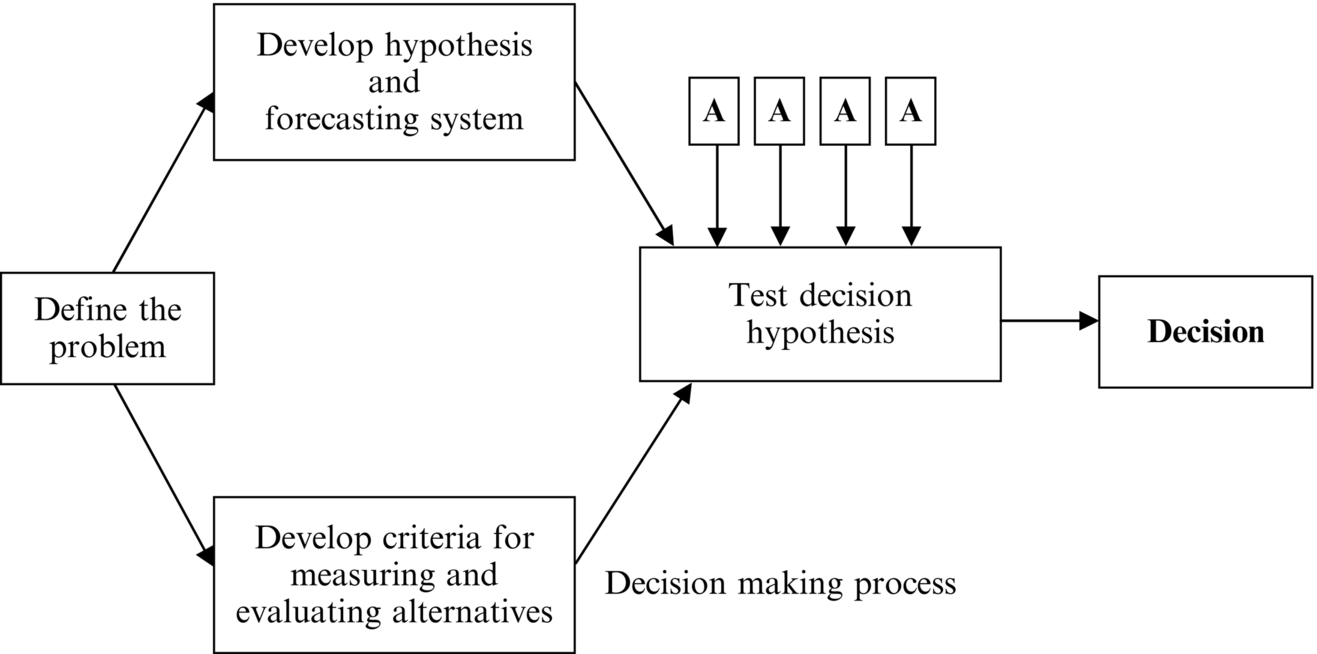
6.20.5 Systematic Decision-Making
This is similar to the above, except that a holistic and systematic approach is given considering all the related factors as part of the whole system. The steps to be undertaken for this approach would be:
2. List the options
3. Think about the possible benefits and consequences of each option
4. Consider your own value and beliefs
5. Weigh the option and then decide which one to take. If possible, share your list with a friend or adult
6. Act
7. Evaluate the results
6.21 Bias in Decision-Making
Wikipedia lists the following instances of bias that creep into to the decision-making process, which should be kept in mind by the decision-makers.
1. Selective search for evidence—Our mind is set for certain conclusions. Subconsciously we tend to gather facts that support these conclusions, but disregard other facts that support different conclusions. This can also be called as Choice-supportive bias.
2. Incomplete search for evidence—We tend to accept the first alternative that looks like it might work.
3. Inertia—We have a built-in resistance to change from our thought patterns that we have used in the past.
4. Selective perception—Referring to para, our brain has two halves, the right brain which is creative and thinks of all alternatives, while the left brain thinks logically and screens out information that appears illogical, even though the same apparent idea could later be developed into a relevant alternative for effective decision-making.
5. Over-optimism—many a time we tend to want to see things in a positive light and ignore the negative impacts.
6. Recency—We tend to place more attention on more recent information, and either ignore or forget more distant information. This is why exponential smoothing is done for forecasting as explained in Chapter 17.
7. Repetition bias—We tend to believe that what we are told more times or by more people is truer than what we are told occasionally, or by fewer people.
8. Anchoring and adjustment—Decisions are unduly influenced by initial information that shapes our view of subsequent information.
9. Groupthink—Even though this is opposite of what is stated in point 4 above and sometimes provides the needed moderation (two heads are better than one), this groupthink sometimes makes groups come into agreement at the cost of critical thinking, that is when most of the group does not want to spend time and energy in analyzing and thinking.
10. Source credibility bias—We reject something if we have a bias against the person and accept a statement by someone we like.
11. Incremental decision-making and escalating commitment—We look at a decision as a small step in a process and this tends to perpetuate a series of similar decisions. This is also called a slippery slope.
12. Attribution asymmetry—We tend to attribute our success to our abilities and talents. But we attribute our failures to bad luck. It is like saying “We won because of me. We lost because of him.”
13. Self-fulfilling decisions—We conform to the decision-making expectations that others have of someone in our position.
14. Underestimating uncertainty—We wrongly presume to have control to minimize potential problems in our decisions.
6.22 Decision Tree
Decision Tree is a pictorial representation of a decision situation, normally found in discussions of decision-making under uncertainty or risk. It shows decision alternatives, states of nature, probabilities attached to the state of nature, and conditional benefits and losses.
Investopedia Financial Dictionary defines decision tree as a management tool to clarify and find an answer to a complex problem. The structure allows users to take a problem with multiple possible solutions and display it in a simple, easy-to-understand format that shows the relationship between different events or decisions. The furthest branches on the tree represent possible end results. The tree approach is most useful in a sequential decision situation and can be illustrated by the logical testing procedure cited in Chapter 8 of the book Maintenance Management—Precepts and Practices (Fig. 6.16).

If a process consisting of a group of units connected in a series as per Fig. 6.16 above fails, then individual units have to be checked for failure since the exact unit which has failed is not known, the decision tree illustrated in Fig. 6.17 would help.
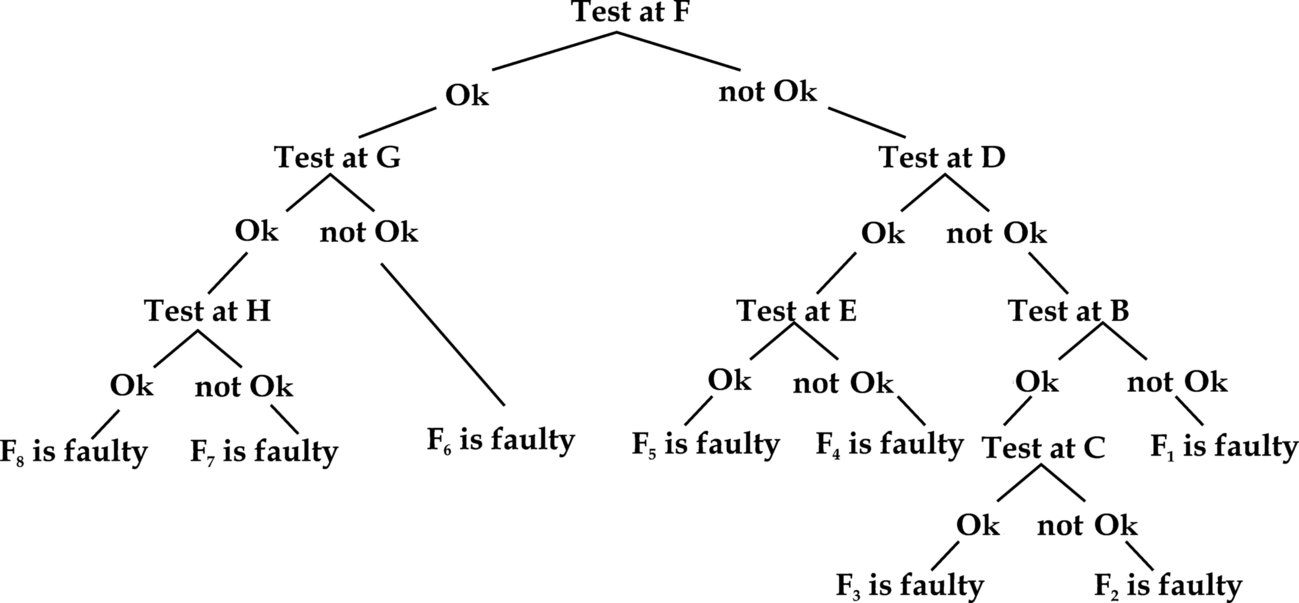
6.23 Systematic Decision-Making
1. Outline your goal and outcome
2. Gather data
3. Develop alternatives (ie, brainstorming)
4. List pros and cons of each alternative
5. Make the decision
6. Immediately take action to implement it
7. Learn from and reflect on the decision
6.24 Proper Management Decision and Proper Engineering Design
The precepts as described in the previous paragraphs have given us new concepts and terminology for distinguishing the managerial and engineering decisions such as proper management decision (PMD) and proper engineering design (PED), which is emphasized more in books on Processional Ethics.
PMD is a decision that should be made by mangers or at least governed by management considerations, because:
● It involves factors relating to the well-being of the organization such as cost, scheduling, marketing, and employee morale and welfare.
● The decision does not force engineers or other professionals to make unacceptable compromises with their own technical practices or ethical standards.
PED is a decision made by the engineers or at least governed by professional engineering practices because it either,
● involves technical matters that require engineering expertise or
● falls within the ethical standards embodied in engineering codes, especially those requiring engineers to protect the health and safety of the public.
6.25 Conclusion
The chief purpose if the systems approach is to provide management with an analytical framework by which it can identify, describe, and interrelate the process and components that make up a particular system. In other words, the systems approach enables a manager to maintain a perspective of the whole process while he analyzes the parts. Again, in the day-to-day administration of the departmental affairs, any manager, especially the planning manager is required to make an endless sequence of decisions. His success depends on his effective decision-making. A clear understanding the precepts and practices of decision theory as detailed in this chapter would help the planning manager. This chapter discussed both of these interrelated precepts.
